Chinese Medicine 医学 yī xué
China's traditional medicine has its roots thousands of years ago. Unlike the situation in Europe, traditional medicine in China is still practiced alongside modern scientific medicine. Since the opening up of China the traditional approach to healthy living has been exported to many other countries. Traditional Chinese Medicine (T.C.M.) is made up of many strands including acupuncture, herbal medicine and moxibustion. The approach is holistic, treating the body as a whole, rather than concentrating on a particular symptom or organ.
Acupuncture
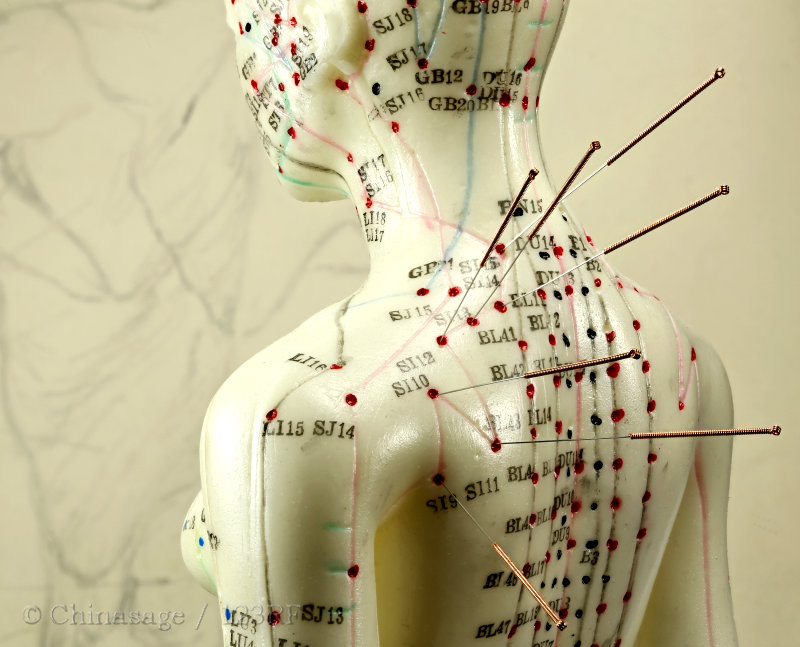
From ancient times it had been discovered that applying pressure to nerves can ameliorate pain. The practitionerBiǎn Què ➚ (扁鹊 ) c. 400BCE is regarded as the pioneer of Chinese medicine and acupuncture in particular. Over the centuries acupuncture points were mapped out over the whole body; each point on the body has specific effects not necessarily at the place where the acupuncture needle is inserted. The acupuncture points are associated with channels that carry qi around the body. Illnesses arise because there is a poor or blocked flow of qi and associated with an imbalance of yin and yang. There are six meridians (茎 ‘jīng’) on either side of the body with one down the middle of the back and front. Seven channels have a ‘yin’ and seven a ‘yang’ association. These acupuncture channels can be used to control yin and yang in complex ways. By the time of the Song dynasty teaching of the needle points had reached the sophistication of using a bronze figure with over 600 points drilled into it. The figure was covered in wax and filled with water. When the student inserted the needle correctly a jet of water would gush out.
Acupuncture can be used to block nerve impulses and so provide a local anesthetic effect. Modern mass studies have confirmed its efficacy but only in some cases. Some practitioners are able to achieve anesthesia with the pressure of fingers alone.
Moxibustion
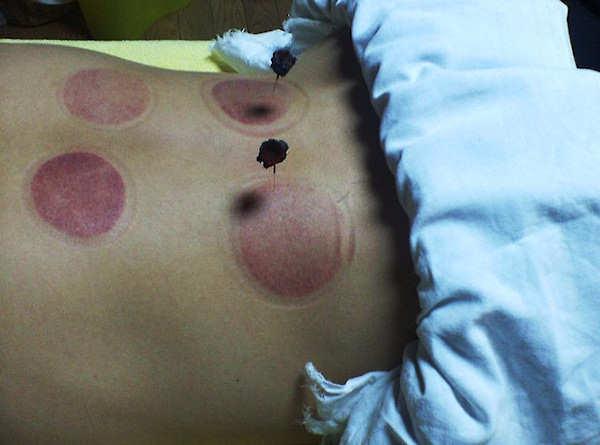
In moxibustion, dried Artemesia (Mugwort) 艾 ài leaves are burned to heat an acupuncture needle after it has been inserted or alternatively the moxa is burned directly to cauterize the skin and form a blister. Mugwort is chosen because it contains substances that help the blood to clot. It is also believed that mugwort may have mild hallucinogenic effects ➚. ‘Cupping’ is a technique that is also used, a jar is filled with heated air and then sealed tight against the skin. The cooling air contracts causing the skin to be forced up into the cup. It is supposed to work by drawing diseases out of the body. A similar technique was used in medieval Europe ➚.
Traditional Chinese Medicine
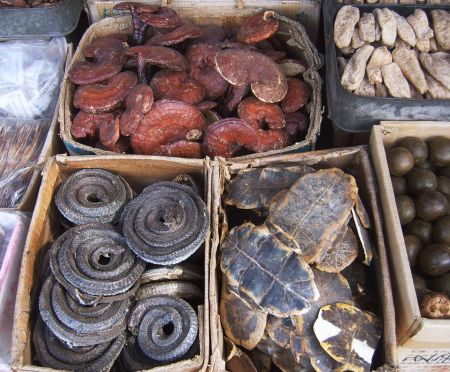
By tradition, the study of medicine goes back to the legendary founder of China: the Yellow Emperor Huangdi. ‘The Inner Canon of Huangdi’ Neijing 黄帝内经 is attributed to him and describes traditional medicine in great depth. It was developed and refined over the centuries. Archaeological evidence of herbal medicine has been found dating back to the Neolithic era in Zhejiang. The legendary god Shennong is considered another pioneer who wrote Shennong's Herbal Classic ➚ 神农本草经 Shén nóng běn cǎo jīng. By the end of the Han dynasty over 400 diseases had been identified with designated treatments.
As with all ancient medicine the taking of the processed (mainly plant) material was associated with a degree of magic and incantation. Doctors were divided into three classes, the imperial doctors who were employed by the court and received a salary; scholars who studied medicine as a sideline helping friends and colleagues on an occasional basis, and finally, untrained doctors who treated the masses. Doctors would concoct their own 'cures' and keep the recipe as a closely guarded family secret. The same cure would be offered by descendents hundreds of years later when the stories of efficacy had spread around. By the Tang dynasty an Imperial Institute of Physicians was setup, the first medical school in the World. In 1111CE a medical encyclopedia was published by imperial decree; this described how a wide variety of plants could be used for pharmaceutical purposes. At one stage it is said that doctors were paid in a strangely inverted insurance scheme - the doctors only received a payment if the insured remained healthy and so giving a strong incentive!
The day of the Dragon Boat festival (fifth day of fifth lunar month) was considered the time to tackle pests and diseases. Realgar ➚ wine was drunk which contains Arsenic sulfide to get rid of any intestinal parasites. Flies and other insects were deterred by hanging a spray of mugwort (Artemisia verlotiorum ) or calanthus (Acorus calamus) above the lintel of the door.
In the Tang dysnaty, Buddhist monks from India brought their medical knowledge to China and detailed books on anatomy were produced. The key medical work for centuries was the Bencao Gangmu ➚ 本草目 (Encyclopedia of Plants and Roots) which has its origin two thousand years ago and was extensively updated in Ming dynasty times. It comprises 52 volumes and 2,000,000 characters. The first European input to Chinese medicine was brought by the Jesuits in the 16th century, they prescribed quinine for treating malaria and antimony for parasitic infections. In the period 1849-1900 many westerners came to appreciate TCM in California; it was Chinese medicine that helped keep all the miners who flooded into the US healthy. It then took some time for them to accept non-Chinese medicine.
Surgery was little practiced in China as there was a strong belief that the whole body should be kept intact and no part should ever be removed. This stems from the holistic belief that a person is healthy when all parts are in balance and harmony which dissection would disrupt. So in historical times, surgery only dealt with external diseases and conditions: skin, fractures, wounds and haemorrhoids. In actual fact before the use of heavy machinery and petrol engines there were relatively few injuries severe enough to require surgery.
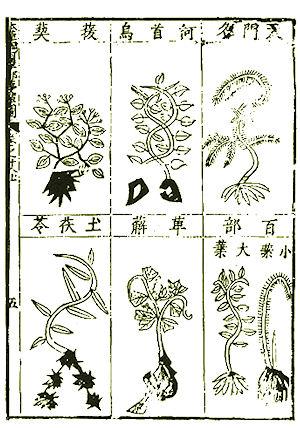
Food elements
The Chinese incorporated medicine within the proto-scientific regime of the five elements, qi and yin-yang. Body organs are associated with particular elements. Foods also have elemental associations and medication seek to restore a balance, so, for example, if someone is feverish then a medicine or food with a cold association is used. The doctrine of yin-yang goes back to the Huangdi's influential Neijing, here it is explained that ‘yang’ represents: outside, back, hot, hollow organs and dark; while ‘yin’ represents: inside, front, cold, solid organs and light. So a pain in the front suggests an imbalance of yin and would be treated with yang substances to correct it. All foods and medicines were categorized on their strength of yin or yang (see our food page for a list).
The five elemental essences of fire, water, metal, wood and earth are associated with specific colors, organs and substances. They have to be kept in balance to achieve overall health. The elements have a creative and destructive cycle so that an excess of one element can be counteracted by taking a substance of the appropriate destructive element. So as fire destroys wood, an illness associated with the wood element is treated by taking a medicine rich in fire (for example peppers). Each element has an associated time of day and a season so the treatments can vary with time and day.
| Heart | veins and arteries | fire |
| Liver | ligaments | wood |
| Spleen | muscles | earth |
| Lungs | large intestine | metal |
| Kidneys | bone; hair | water |
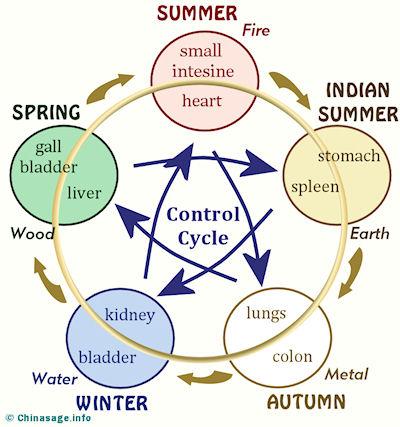
Tiger bones and scarab beetles
Most medicines are mixtures of roots, bark, fungi and leaves; sometimes including ground up animal parts (such as snakes, fish, toads). Some of the more exotic ingredients are sea horses for childbirth; scarab beetles for polyps; piles and dysentery; carp for coughs and asthma; hornet's nest for poisons; berberis for stomach pain; frogs for boils; centipede for snakebites, malaria and reindeer antler for impotence. Usually boiling water is added to the mixture and the infusion is then drunk as a 'tea'.
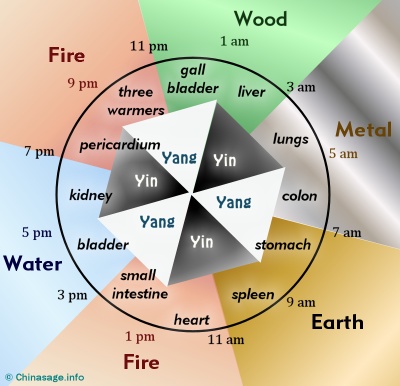
The use of endangered tiger, sea horse, elephant ivory, pangolin, rhinoceros and other species in medicines continues to cause concern as the high price of these animal parts has promoted illegal trade. Rhinoceros 犀牛 xī niú horn was particularly valued as a medicine, it was also used for making drinking cups. It is not true that it is considered as an aphrodisiac in fact it is considered a general tonic or energizer. Only a few body parts are used from these animals in TCM and there is no proven efficacy. Tiger bone, for instance, was supposed to help with arthritis; the belief was based on the false premise that tigers were never seen to limp. The trade continues really only because being able to afford exotic medicines is still seen as a badge of wealth.
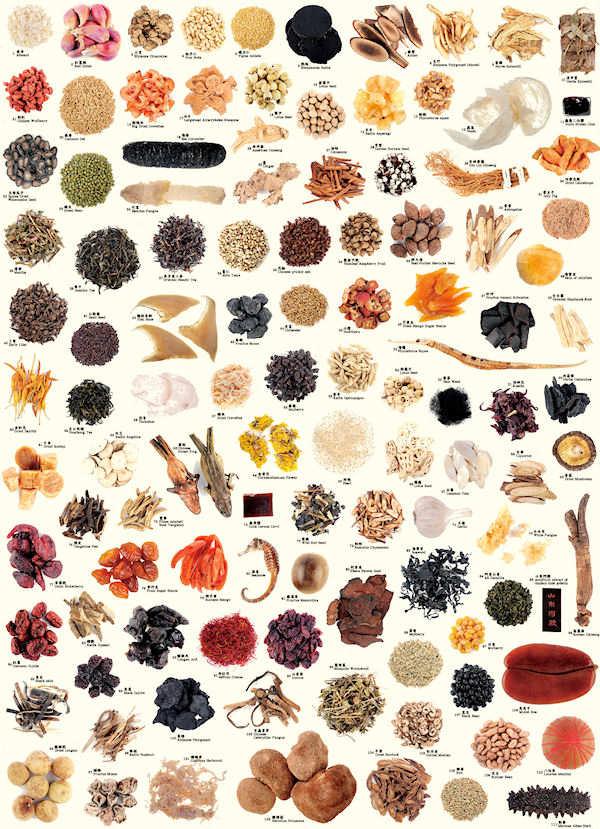
Ancient wisdom
The massive Bencao Gangmu ➚ encyclopedia (1596) ‘Compendium of medical materials’ written by Li Shizhen ➚ lists 1,892 drugs of which 1,094 have plant origin, 444 animal and 354 mineral. Of these many would have little or no effect, and a few made the patient worse (for example mercury and sulfur) while others are now known to be efficacious (Omphalia lapidescens ➚ for tape worm; Kaolin for diarrhea; Dichroa febrifuga for fevers; Ephedra sinica for asthma). A good example of such a health product are goji ➚ or wolfberries which are now eaten as a healthy food worldwide; the berries were traditionally used for treating high blood pressure and fever. Ginseng ➚ (Reshen 人参) is another traditional medicine extolled as a health food. Ginseng is an example of a plant that came into use because the shape of its roots look like the body of a person.
Folk tradition
The traditions and medicines must be put in the context of world medicine. Most cultures developed herbal remedies in the same rather ad hoc way. Every village in medieval England would have had a herbalist well versed in use of herbs to cure ills. Many cures were based on similarity of appearance (the Doctrine of Signatures ➚), for example the markings of the leaves of lungwort ➚ look like lungs and so it was assumed it must therefore be good for curing lung ailments. Plants with fruits shaped like kidneys must be good for the kidneys and so on. In many instances it was impossible to prove if a treatment was effective as there is no 'control' to compare with – the patient may well have got better anyway. However it is very likely that herbs that have a detrimental effect would have been dropped over the centuries – the long tradition of the treatments will show up benefits particularly when compared to ‘new’ pharmaceuticals with no track record. The placebo effect is also very strong, a practitioner who is supremely confidant of the efficacy of the medicine undoubtedly influences the mindset of the patient. Some treatments were definitely staged for effect, Lu Xun wrote of a supposed cure for tuberculosis that entailed eating bread soaked in the blood of an executed criminal.
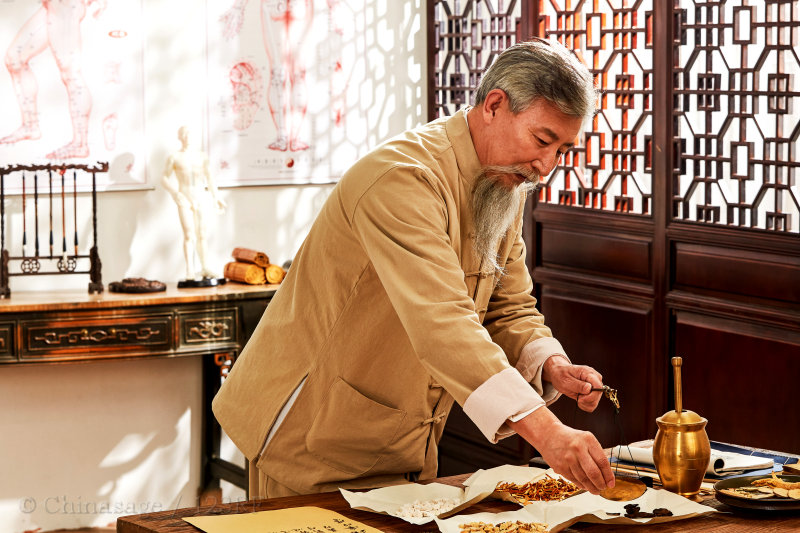
Consultation
A traditional diagnosis is a thorough process, the doctor listens carefully to the patient. Particular attention is paid to the tongue and complexion. The acupuncture channels are felt and the pulse measured on both the left and right sides. Measuring the pulse accurately may take up to half an hour. The diagnosis follows rules to determine the problem, always seeking where a yin-yang imbalance may be located. As it is a holistic approach the treatment is not just the taking of a medicine; it also involves diet, massage, breathing and exercise. Because a Chinese doctor will produce a diagnosis and set of medicines specific to the patient it is hard to directly compare efficacy with western medicine.
Vaccination
There are records of variolation ➚ as long ago as the Song dynasty, patients were exposed to smallpox ➚ for a short time and this provided immunity from later infection. The method was to inhale the contents of dried infected pustules. In the Ming dynasty this form of vaccination became widespread as smallpox was a serious condition affecting the majority of people in China. Bearing smallpox pockmarks was seen for centuries as a badge of reaching maturity.
Western and Traditional Chinese Medicine
When China rejected Western science in the Cultural Revolution the position of medicine proved a thorny issue. Mao Zedong much admired the work of Norman Bethune ➚ a Canadian who worked with the wounded Communists troops and did much to demonstrate the superiority of western medicine. At the time there were very few western trained doctors in China so a twin track approach was adopted of western medicine in cities and a system of bare-foot doctors using a mixture of traditional and western techniques in rural areas. TCM was one of the few traditions that was protected during the Cultural Revolution when most 'old' customs were denigrated and abandoned. Mao used the maxim It is better to walk on two legs than one to justify the use of western medicine alongside traditional medicine. By collecting together all traditional remedies used over the whole country it was possible for the government to separate good from bad medicines. It was also the case that at the time there was no money available to provide western medicine to the whole country. Traditional Chinese medicine is still used for minor ailments and when modern medicine fails to provide answers, as for example with chronic pain.